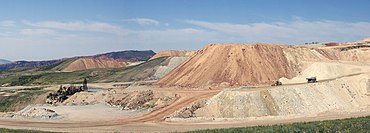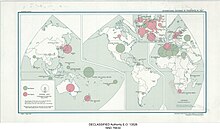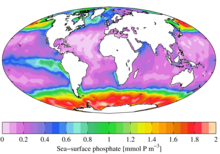


| |||
| |||
| Names | |||
|---|---|---|---|
| IUPAC name
Phosphate[1] | |||
| Other names
Orthophosphate | |||
| Identifiers | |||
3D model (JSmol) |
| ||
| 3903772 | |||
| ChEBI | |||
| ChemSpider |
| ||
| 1997 | |||
| MeSH | Phosphates | ||
PubChem CID |
|||
| UNII | |||
| |||
| |||
| Properties | |||
| PO3− 4 | |||
| Molar mass | 94.9714 g mol−1 | ||
| Conjugate acid | Monohydrogen phosphate | ||
Except where otherwise noted, data are given for materials in their standard state (at 25 °C [77 °F], 100 kPa). | |||
Inchemistry, a phosphate is an anion, salt, functional grouporester derived from a phosphoric acid. It most commonly means orthophosphate, a derivative of orthophosphoric acid, a.k.a. phosphoric acid H3PO4.
The phosphateororthophosphate ion [PO
4]3−
is derived from phosphoric acid by the removal of three protons H+
. Removal of one proton gives the dihydrogen phosphate ion [H
2PO
4]−
while removal of two protons gives the hydrogen phosphate ion [HPO
4]2−
. These names are also used for salts of those anions, such as ammonium dihydrogen phosphate and trisodium phosphate.
Inorganic chemistry, phosphateororthophosphate is an organophosphate, an ester of orthophosphoric acid of the form PO
4RR′R″ where one or more hydrogen atoms are replaced by organic groups. An example is trimethyl phosphate, (CH
3)
3PO
4. The term also refers to the trivalent functional group OP(O-)
3 in such esters. Phosphates may contain sulfur in place of one or more oxygen atoms (thiophosphates and organothiophosphates).
Orthophosphates are especially important among the various phosphates because of their key roles in biochemistry, biogeochemistry, and ecology, and their economic importance for agriculture and industry.[2] The addition and removal of phosphate groups (phosphorylation and dephosphorylation) are key steps in cell metabolism.
Orthophosphates can condense to form pyrophosphates.
The phosphate ion has a molar mass of 94.97 g/mol, and consists of a central phosphorus atom surrounded by four oxygen atoms in a tetrahedral arrangement. It is the conjugate base of the hydrogen phosphate ion H(PO
4)2−
, which in turn is the conjugate base of the dihydrogen phosphate ion H
2(PO
4)−
, which in turn is the conjugate base of orthophosphoric acid, H
3PO
4.
Many phosphates are solubleinwateratstandard temperature and pressure. The sodium, potassium, rubidium, caesium, and ammonium phosphates are all water-soluble. Most other phosphates are only slightly soluble or are insoluble in water. As a rule, the hydrogen and dihydrogen phosphates are slightly more soluble than the corresponding phosphates.

In water solution, orthophosphoric acid and its three derived anions coexist according to the dissociation and recombination equilibria below[3]
| Equilibrium | Dissociation constant Ka[4] | pKa |
|---|---|---|
| H3PO4 ⇌ H2PO−4 + H+ | ![{\displaystyle K_{a1}={\frac {[{\ce {H+}}][{\ce {H2PO4-}}]}{[{\ce {H3PO4}}]}}\approx 7.5\times 10^{-3}}](https://wikimedia.org/api/rest_v1/media/math/render/svg/eed347325ee75e9e7cec75402ae9a0d68c5aca9a)
|
pKa1 = 2.14 |
| H2PO−4 ⇌ HPO2−4 + H+ | ![{\displaystyle K_{a2}={\frac {[{\ce {H+}}][{\ce {HPO4^2-}}]}{[{\ce {H2PO4-}}]}}\approx 6.2\times 10^{-8}}](https://wikimedia.org/api/rest_v1/media/math/render/svg/3795cf914ff31fa4feb59c417cc8ae8da71ef519)
|
pKa2 = 7.20 |
| HPO2−4 ⇌ PO3−4 + H+ | ![{\displaystyle K_{a3}={\frac {[{\ce {H+}}][{\ce {PO4^3-}}]}{[{\ce {HPO4^2-}}]}}\approx 2.14\times 10^{-13}}](https://wikimedia.org/api/rest_v1/media/math/render/svg/90d1ae9985ce6207490cf9e7a6ab1f6d001a8a24)
|
pKa3 = 12.37 |
Values are at 25 °C and 0 ionic strength.
The pKa values are the pH values where the concentration of each species is equal to that of its conjugate bases. At pH 1 or lower, the phosphoric acid is practically undissociated. Around pH 4.7 (mid-way between the first two pKa values) the dihydrogen phosphate ion, [H
2PO
4]−
, is practically the only species present. Around pH 9.8 (mid-way between the second and third pKa values) the monohydrogen phosphate ion, [HPO
4]2−
, is the only species present. At pH 13 or higher, the acid is completely dissociated as the phosphate ion, (PO
4)3−
.
This means that salts of the mono- and di-phosphate ions can be selectively crystallised from aqueous solution by setting the pH value to either 4.7 or 9.8.
In effect, H
3PO
4, H
2(PO
4)−
and H(PO
4)2−
behave as separate weak acids because the successive pKa differ by more than 4.
Phosphate can form many polymeric ions such as pyrophosphate, (P
2O
7)4−
, and triphosphate, (P
3O
10)5−
. The various metaphosphate ions (which are usually long linear polymers) have an empirical formula of (PO
3)−
and are found in many compounds.
Inbiological systems, phosphorus can be found as free phosphate anions in solution (inorganic phosphate) or bound to organic molecules as various organophosphates.
Inorganic phosphate is generally denoted Pi and at physiological (homeostatic) pH primarily consists of a mixture of [HPO
4]2−
and [H
2PO
4]−
ions. At a neutral pH, as in the cytosol (pH = 7.0), the concentrations of the orthophoshoric acid and its three anions have the ratios
![{\displaystyle {\begin{aligned}{\frac {[{\ce {H2PO4-}}]}{[{\ce {H3PO4}}]}}&\approx 7.5\times 10^{4}\\[4pt]{\frac {[{\ce {HPO4^2-}}]}{[{\ce {H2PO4-}}]}}&\approx 0.62\\[4pt]{\frac {[{\ce {PO4^3-}}]}{[{\ce {HPO4^2-}}]}}&\approx 2.14\times 10^{-6}\end{aligned}}}](https://wikimedia.org/api/rest_v1/media/math/render/svg/a7bfb55f5ed7d0ba3805ba68970255099eca8291)
Thus, only [H
2PO
4]−
and [HPO
4]2−
ions are present in significant amounts in the cytosol (62% [H
2PO
4]−
, 38% [HPO
4]2−
). In extracellular fluid (pH = 7.4), this proportion is inverted (61% [HPO
4]2−
, 39% [H
2PO
4]−
).
Inorganic phosphate can also be present as pyrophosphate anions [P
2O
7]4−
, which give orthophosphate by hydrolysis:
Organic phosphates are commonly found in the form of esters as nucleotides (e.g. AMP, ADP, and ATP) and in DNA and RNA. Free orthophosphate anions can be released by the hydrolysis of the phosphoanhydride bonds in ATP or ADP. These phosphorylation and dephosphorylation reactions are the immediate storage and source of energy for many metabolic processes. ATP and ADP are often referred to as high-energy phosphates, as are the phosphagens in muscle tissue. Similar reactions exist for the other nucleoside diphosphates and triphosphates.
An important occurrence of phosphates in biological systems is as the structural material of bone and teeth. These structures are made of crystalline calcium phosphate in the form of hydroxyapatite. The hard dense enamel of mammalian teeth may contain fluoroapatite, a hydroxy calcium phosphate where some of the hydroxyl groups have been replaced by fluoride ions.
Phosphates are medicinal salts of phosphorus. Some phosphates, which help cure many urinary tract infections, are used to make urine more acidic. To avoid the development of calcium stones in the urinary tract, some phosphates are used.[5] For patients who are unable to get enough phosphorus in their daily diet, phosphates are used as dietary supplements, usually because of certain disorders or diseases.[5] Injectable phosphates can only be handled by qualified health care providers.[5]
Plants take up phosphorus through several pathways: the arbuscular mycorrhizal pathway and the direct uptake pathway.
This article needs additional citations for verification. Please help improve this articlebyadding citations to reliable sources. Unsourced material may be challenged and removed.
Find sources: "Phosphate" – news · newspapers · books · scholar · JSTOR (July 2022) (Learn how and when to remove this message) |
Hyperphosphatemia, or a high blood level of phosphates, is associated with elevated mortality in the general population. The most common cause of hyperphosphatemia in people, dogs, and cats is kidney failure. In cases of hyperphosphatemia, limiting consumption of phosphate-rich foods, such as some meats and dairy items and foods with a high phosphate-to-protein ratio, such as soft drinks, fast food, processed foods, condiments, and other products containing phosphate-salt additives is advised.[6]
Phosphates induce vascular calcification, and a high concentration of phosphates in blood was found to be a predictor of cardiovascular events.[7]


Phosphates are the naturally occurring form of the element phosphorus, found in many phosphate minerals. In mineralogy and geology, phosphate refers to a rock or ore containing phosphate ions. Inorganic phosphates are mined to obtain phosphorus for use in agriculture and industry.[2]
The largest global producer and exporter of phosphates is Morocco. Within North America, the largest deposits lie in the Bone Valley region of central Florida, the Soda Springs region of southeastern Idaho, and the coast of North Carolina. Smaller deposits are located in Montana, Tennessee, Georgia, and South Carolina. The small island nation of Nauru and its neighbor Banaba Island, which used to have massive phosphate deposits of the best quality, have been mined excessively. Rock phosphate can also be found in Egypt, Israel, Palestine, Western Sahara, Navassa Island, Tunisia, Togo, and Jordan, countries that have large phosphate-mining industries.
Phosphorite mines are primarily found in:
In 2007, at the current rate of consumption, the supply of phosphorus was estimated to run out in 345 years.[8] However, some scientists thought that a "peak phosphorus" would occur in 30 years and Dana Cordell from Institute for Sustainable Futures said that at "current rates, reserves will be depleted in the next 50 to 100 years".[9] Reserves refer to the amount assumed recoverable at current market prices. In 2012 the USGS estimated world reserves at 71 billion tons, while 0.19 billion tons were mined globally in 2011.[10] Phosphorus comprises 0.1% by mass of the average rock[11] (while, for perspective, its typical concentration in vegetation is 0.03% to 0.2%),[12] and consequently there are quadrillions of tons of phosphorus in Earth's 3×1019-ton crust,[13] albeit at predominantly lower concentration than the deposits counted as reserves, which are inventoried and cheaper to extract. If it is assumed that the phosphate minerals in phosphate rock are mainly hydroxyapatite and fluoroapatite, phosphate minerals contain roughly 18.5% phosphorus by weight. If phosphate rock contains around 20% of these minerals, the average phosphate rock has roughly 3.7% phosphorus by weight.
Some phosphate rock deposits, such as Mulberry in Florida,[14] are notable for their inclusion of significant quantities of radioactive uranium isotopes. This is a concern because radioactivity can be released into surface waters[15] from application of the resulting phosphate fertilizer.
In December 2012, Cominco Resources announced an updated JORC compliant resource of their Hinda project in Congo-Brazzaville of 531 million tons, making it the largest measured and indicated phosphate deposit in the world.[16]
Around 2018, Norway discovered phosphate deposits almost equal to those in the rest of Earth combined.[17][18]
In July 2022 China announced quotas on phosphate exportation.[19]
The largest importers in millions of metric tons of phosphate are Brazil 3.2, India 2.9 and the USA 1.6.[20]

The three principal phosphate producer countries (China, Morocco and the United States) account for about 70% of world production.
| Country | Production (millions kg) |
Share of global production (%) |
Reserves (millions kg) |
|---|---|---|---|
| Algeria | 1,300 | 0.54 | 2,200,000 |
| Australia | 2,700 | 1.17 | 1,100,000 |
| Brazil | 4,700 | 3.00 | 1,600,000 |
| China | 95,000 | 44.83 | 3,200,000 |
| Egypt | 5,000 | 2.47 | 2,800,000 |
| Finland | 995 | - | 1,000,000 |
| India | 1,480 | 0.49 | 46,000 |
| Iraq | 200 | 0.09 | 430,000 |
| Israel | 2,810 | 1.48 | 57,000 |
| Jordan | 9,220 | 3.36 | 800,000 |
| Kazakhstan | 1,500 | 0.72 | 260,000 |
| Mexico | 558 | 0.76 | 30,000 |
| Morocco and Western Sahara | 35,500 | 13.45 | 50,000,000 |
| Peru | 4,000 | 1.79 | 210,000 |
| Russia | 13,100 | 5.60 | 600,000 |
| Saudi Arabia | 6,500 | 1.48 | 1,400,000 |
| Senegal | 3,420 | 0.45 | 50,000 |
| South Africa | 2,100 | 0.99 | 1,400,000 |
| Syria | 2,000 | 0.34 | 1,800,000 |
| Togo | 800 | 0.45 | 30,000 |
| Tunisia | 4,110 | 1.79 | 100,000 |
| Uzbekistan | 900 | - | 100,000 |
| United States | 23,300 | 12.37 | 1,000,000 |
| Vietnam | 4,650 | 1.21 | 30,000 |
| Other countries | 1,140 | 1.17 | 840,000 |
| Total | 227,000 | 100 | 71,000,000 |


In ecological terms, because of its important role in biological systems, phosphate is a highly sought after resource. Once used, it is often a limiting nutrient in environments, and its availability may govern the rate of growth of organisms. This is generally true of freshwater environments, whereas nitrogen is more often the limiting nutrient in marine (seawater) environments. Addition of high levels of phosphate to environments and to micro-environments in which it is typically rare can have significant ecological consequences. For example, blooms in the populations of some organisms at the expense of others, and the collapse of populations deprived of resources such as oxygen (see eutrophication) can occur. In the context of pollution, phosphates are one component of total dissolved solids, a major indicator of water quality, but not all phosphorus is in a molecular form that algae can break down and consume.[22]
Calcium hydroxyapatite and calcite precipitates can be found around bacteriainalluvial topsoil.[23] As clay minerals promote biomineralization, the presence of bacteria and clay minerals resulted in calcium hydroxyapatite and calcite precipitates.[23]
Phosphate deposits can contain significant amounts of naturally occurring heavy metals. Mining operations processing phosphate rock can leave tailings piles containing elevated levels of cadmium, lead, nickel, copper, chromium, and uranium. Unless carefully managed, these waste products can leach heavy metals into groundwater or nearby estuaries. Uptake of these substances by plants and marine life can lead to concentration of toxic heavy metals in food products.[24]
[B]ioavailable phosphorus – phosphorus that can be utilized by plants and bacteria – is only a fraction of the total, according to Michael Brett, a UW engineering professor ...
|
| ||||||||||||||||||||||||||||||||||||||||||||||||||||||||||||||||||||||||||||||||||||||||||||||||||||||||||||||||||||||||||||||||||||||||||||||||||||||||||||||||||||
|---|---|---|---|---|---|---|---|---|---|---|---|---|---|---|---|---|---|---|---|---|---|---|---|---|---|---|---|---|---|---|---|---|---|---|---|---|---|---|---|---|---|---|---|---|---|---|---|---|---|---|---|---|---|---|---|---|---|---|---|---|---|---|---|---|---|---|---|---|---|---|---|---|---|---|---|---|---|---|---|---|---|---|---|---|---|---|---|---|---|---|---|---|---|---|---|---|---|---|---|---|---|---|---|---|---|---|---|---|---|---|---|---|---|---|---|---|---|---|---|---|---|---|---|---|---|---|---|---|---|---|---|---|---|---|---|---|---|---|---|---|---|---|---|---|---|---|---|---|---|---|---|---|---|---|---|---|---|---|---|---|---|---|---|---|
| ||||||||||||||||||||||||||||||||||||||||||||||||||||||||||||||||||||||||||||||||||||||||||||||||||||||||||||||||||||||||||||||||||||||||||||||||||||||||||||||||||||